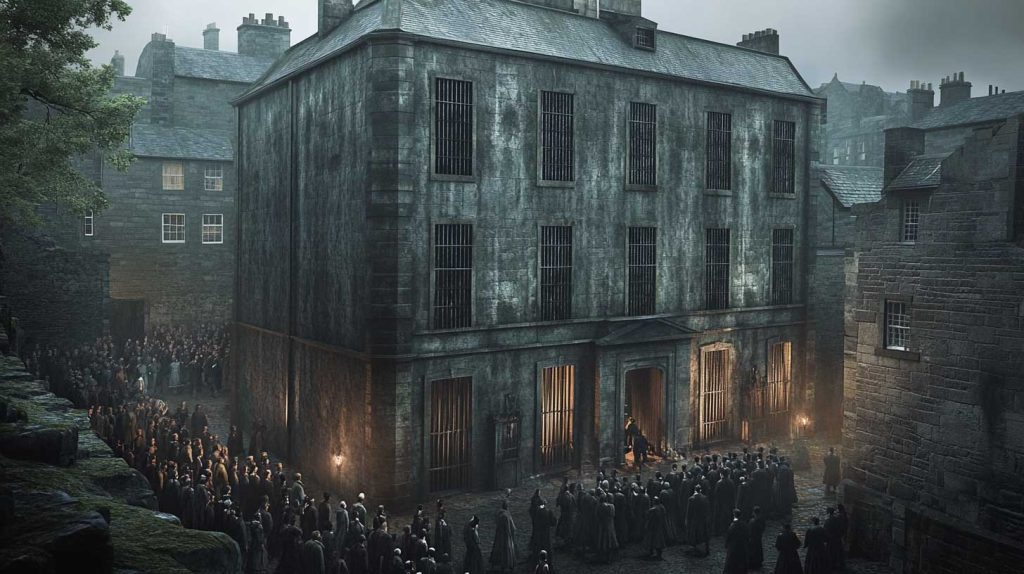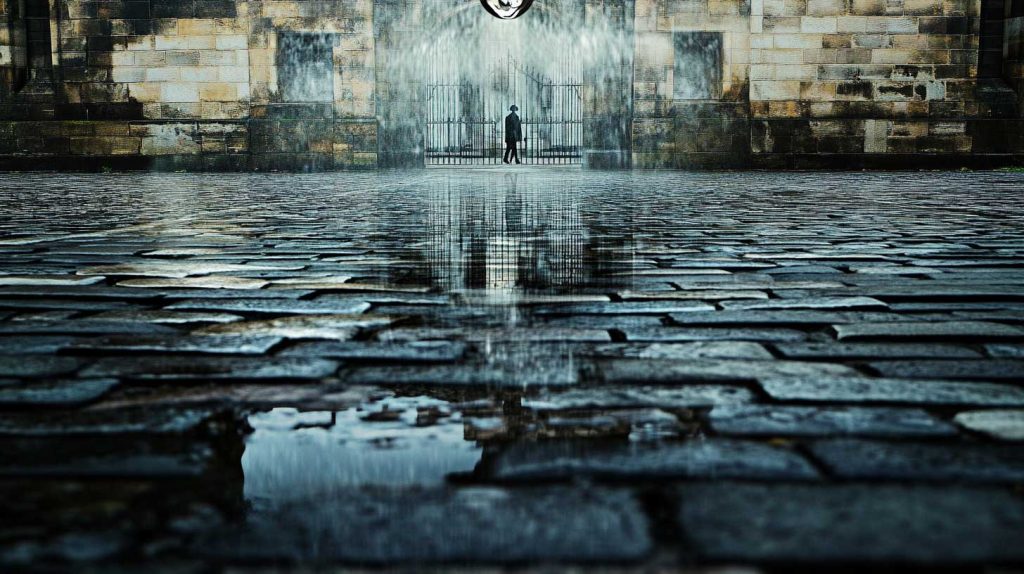
The Bloody Heart of Midlothian: Fact vs Fiction
The Heart of Midlothian lies on the Royal Mile. A curious mosaic of cobblestones shaped like a heart. Tourists pause, puzzled, as locals casually spit onto its center. A symbol that confuses, intrigues, and ties Edinburgh’s present to its brutal past.
The true Heart of Midlothian meaning is not a single tale but a layered history — one part grim fact, one part folklore, and one part living tradition. To understand it is to uncover centuries of cruelty, rebellion, and memory etched into the city’s stones.
The Stone Heart: What Exactly Is It?
The mosaic you see today is a pattern of granite setts, set into the pavement in the early 1990s as a permanent memorial. But the site it marks is far older and far darker.
It stands where the entrance to the Old Tollbooth once loomed, a building that dominated the High Street for more than 400 years. The Tollbooth was Edinburgh’s administrative and judicial hub: council chambers, parliament, courthouse, and, most notoriously, its prison. The modern mosaic is not ancient, but it is a scar marking where the city’s heart of punishment once beat.
The Tollbooth: Edinburgh’s “Heart of Darkness”

By the 17th and 18th centuries, the Old Tollbooth was infamous. Prisoners were crammed into foul, overcrowded cells described by contemporaries as “reeking” and “loathsome.”
Executions took place at its doorway. Criminals, traitors, and political dissidents were led out to the jeering crowds; many were hanged on the spot. The severed heads of the condemned were displayed on spikes above its roof, a warning to all who passed beneath.
Because it stood at the literal and symbolic center of Edinburgh, the Tollbooth earned its grim nickname: “the Heart of Midlothian.” This is the first and most factual meaning — the building was the feared core of royal justice, radiating power and punishment into every corner of the city.
The Folklore: A Romantic but False Tale
Over time, myth softened the Tollbooth’s cruelty with a fictional story. One oft-told legend speaks of a condemned man whose lover watched from across the street until his execution. When he was killed, his heart was supposedly cut out and hurled toward her lodgings, landing on the cobbles where a heart-shaped marker later appeared.
It’s a dramatic story — part Gothic romance, part horror — but there is no historical record of such an event. Like many Edinburgh legends, it was likely invented to give a bloody site a more poetic twist. The Heart of Midlothian meaning here is folklore, not fact: an attempt to cloak brutality in tragic love.
The Ritual: Why Do People Spit on It?

Today the most visible aspect of the heart is the custom of spitting on it. To outsiders, it seems disrespectful — why spit on a historic monument? But the ritual has layers.
Gesture of defiance: The oldest explanation is contempt. Spitting symbolized disdain for the Tollbooth, its executions, and the harsh justice it represented. Every gob of spit was a small rebellion against authority.
Charm of good luck: Over time, the defiance softened into superstition. Edinburgh locals (and now tourists) spit on the heart for good luck, often before exams, weddings, or even football matches.
Quirky tradition: For many, it’s simply habit — something you “just do” in Edinburgh, even if the origins are half-forgotten.
The most credible origin is defiance, but its modern life is playful. The act of spitting on the Heart of Midlothian connects today’s citizens with centuries of resentment, rebellion, and ritual.
The Football Club: A Modern Rebirth
In 1874, nearly a century after the Tollbooth was demolished, a group of young men in Edinburgh formed a football team. They named it Heart of Midlothian Football Club, adopting the emblem of the heart itself.
For the club’s supporters, the Heart of Midlothian meaning shifted again — from a symbol of cruelty and contempt to one of pride and local identity. Their badge still features the iconic maroon-and-gold heart, tying modern sport to medieval justice in a way only Edinburgh could manage.
Fact vs. Fiction: Untangling the Threads

To truly understand the Heart of Midlothian, we must separate fact from legend:
FACT:
- The heart mosaic marks the doorway of the Old Tollbooth prison.
- The Tollbooth was a center of law, incarceration, and execution.
- The building was nicknamed the “Heart of Midlothian.”
- Spitting on the spot originated as a gesture of contempt.
FICTION:
- The heart does not mark a place where a lover’s heart was cast.
- The tragic romance story is later folklore with no evidence.
- The mosaic is a modern memorial, not an ancient artifact.
The Heart of Midlothian: A Heart That Still Beats

The Heart of Midlothian meaning is not fixed — it has changed with the city itself. Once a place of cruelty and punishment, then a canvas for folklore, now a ritual of luck and identity.
To spit on the heart is to take part in centuries of history, whether you know it or not. It is a symbolic act that unites rebellion with tradition, contempt with continuity.
Edinburgh remembers not only in museums and monuments, but also in habits, rituals, and the very stones beneath its people’s feet. The Heart of Midlothian proves that history need not be grand to endure; sometimes it is a small mosaic, marked by spit, carrying a city’s memory forward.













No Comments